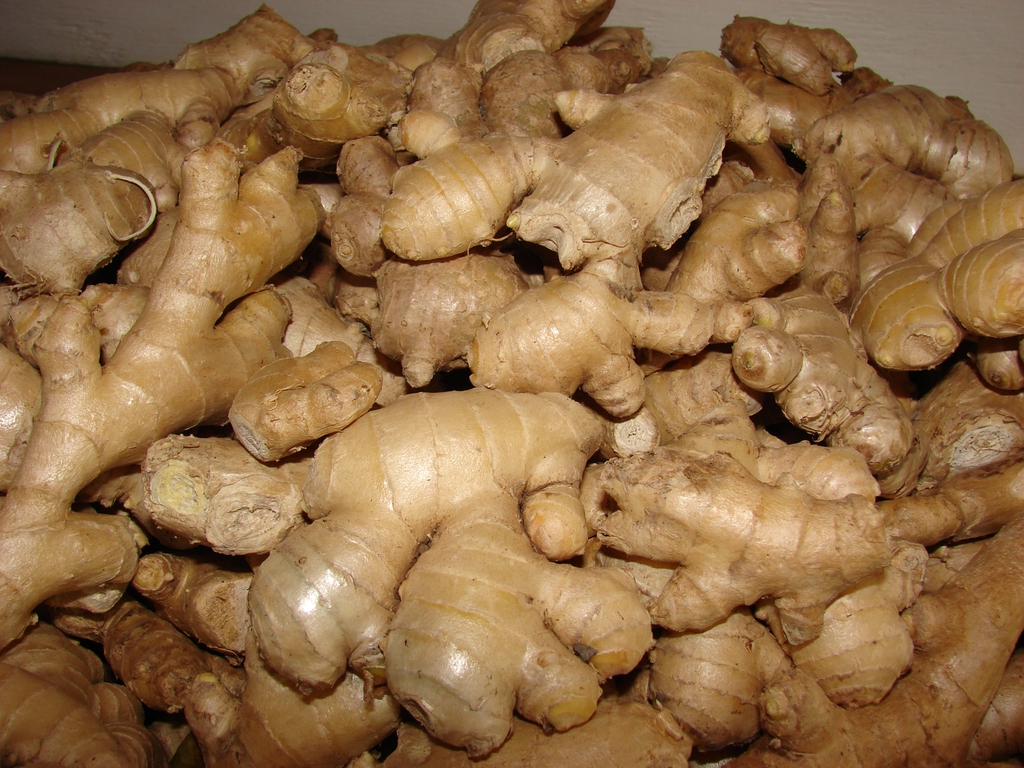Zingiber officinale

|
|
Zingiber officinale Common Names: Ginger, Garden Ginger, True Ginger Scientific
Classification Kingdom: Plantae Clade: Tracheophytes Clade: Angiosperms Clade: Monocots Clade: Commelinids Order: Zingiberales Family: Zingiberaceae Genus: Zingiber Species: Z. officinale Binomial Name: Zingiber officinale Roscoe Synonyms: Amomum angustifolium Salisb., Amomum zingiber L., Curcuma longifolia Wall., Zingiber aromaticum Noronha, Zingiber blancoi Hassk., Zingiber majus Rumph., Zingiber sichuanense Z.Y.Zhu et al. Morphological Description Zingiber officinale, commonly known as ginger, is a perennial herbaceous plant
reaching 0.6–1.2 m in height. It features: · Rhizome: Fleshy, knobby, 2–4 cm thick, yellowish-brown, aromatic with
a pungent taste · Pseudostems: Erect, 50–100 cm tall, formed by rolled leaf sheaths, green · Leaves: Lanceolate, 15–30 cm long, 2–3 cm wide, glossy green,
arranged alternately · Flowers: Pale yellow with purple edges, 4–5 cm long, in dense
cone-like spikes on separate shoots The rhizome, the primary
harvested part, is prized for its spicy flavor and medicinal value (Ravindran
& Babu, 2016). Distribution and Habitat Zingiber officinale originated in Maritime Southeast Asia, domesticated by
Austronesian peoples around 5,000 years ago. It is now cultivated globally in
tropical and subtropical regions, including India (largest producer), China,
Nigeria, and Jamaica. It thrives in: · Habitats: Humid forests, plantations, shaded gardens · Climate: Warm, humid, with rainfall of 1,500–3,000 mm annually,
temperatures of 20–30°C · Soil Conditions: Well-drained, loamy soils rich in organic
matter (pH 5.5–6.5) · Elevation: Sea level to 1,500 m Ethnopharmacology Zingiber officinale, commonly known as ginger, is a globally recognized medicinal
plant with a long history of use in traditional medicine systems such as
Ayurveda, Chinese, and African medicine. Its rhizome is the primary part used
for therapeutic purposes and is known for its powerful anti-inflammatory,
antioxidant, analgesic, antimicrobial, antiemetic, antidiabetic, cardioprotective,
and digestive properties. Ginger is widely used to treat nausea, vomiting,
indigestion, cold and flu symptoms, arthritis, menstrual pain, and inflammatory
conditions. It is also believed to help regulate blood sugar levels, lower
cholesterol, and improve circulation. Bioactive compounds such as gingerol,
shogaol, and zingerone are primarily responsible for its medicinal effects.
Extensively studied in both traditional and modern medicine, ginger is
generally considered safe and effective, though appropriate dosing and medical
supervision are advised, especially when used alongside pharmaceuticals. · Anti-inflammatory: Rhizome used in India for arthritis. · Antioxidant: Gingerols scavenge DPPH radicals (IC₅₀ 10 µg/mL), used in
China for oxidative stress (Mao et al., 2019). · Antiemetic: Reduces nausea in pregnancy (70% efficacy at 1 g/day), used
in Thailand for morning sickness (Vutyavanich et al., 2001). · Digestive Aid: Enhances gastric motility (20% increase at 500 mg), used in
Nigeria for indigestion (Giacosa et al., 2015). · Analgesic: Decreases pain in osteoarthritis (30% at 250 mg/day), used
in Malaysia for muscle pain (Altman & Marcussen, 2001). · Antimicrobial: Inhibits Escherichia coli (MIC 50 µg/mL), used in Ghana for
infections (Akoachere et al., 2002). · Anticancer: 6-Shogaol induces apoptosis in colorectal cancer cells (IC₅₀
7.5 µM), explored in Korea (Pan et al., 2008). ⚠ Toxicity Profile: Safe at culinary doses (up to 4 g/day); LD₅₀
> 5,000 mg/kg in rats. High doses (>5 g/day) may cause heartburn or
diarrhea. May potentiate anticoagulants or lower blood sugar excessively;
caution advised in pregnancy beyond food amounts (Ali et al., 2008). Phytochemistry Ginger’s therapeutic
effects are driven by a diverse phytochemical profile: · Gingerols: [6]-Gingerol, [8]-Gingerol, anti-inflammatory and analgesic · Shogaols: [6]-Shogaol, more potent post-drying, anticancer potential · Zingerone: Antioxidant, formed during cooking · Essential Oils: Zingiberene (30–70%), β-bisabolene,
antimicrobial · Phenolics: Paradol, antioxidant and anti-inflammatory Fresh rhizomes are
richer in gingerols, while dried ones have higher shogaol content (Mao et al.,
2019). Additional Uses · Culinary: Rhizome flavors curries, teas, and baked goods worldwide · Cosmetic: Essential oil in perfumes and skincare for fragrance · Cultural: Used in Ayurvedic tonics in India for vitality · Industrial: Extracts in beverages like ginger ale References
External Links More Pictures |
|
| Compounds of Zingiber officinale |
|
| References |